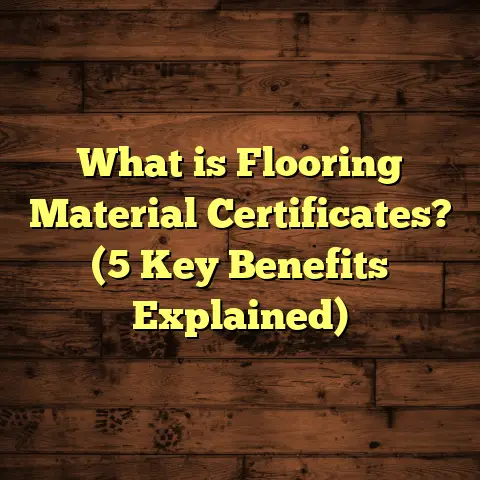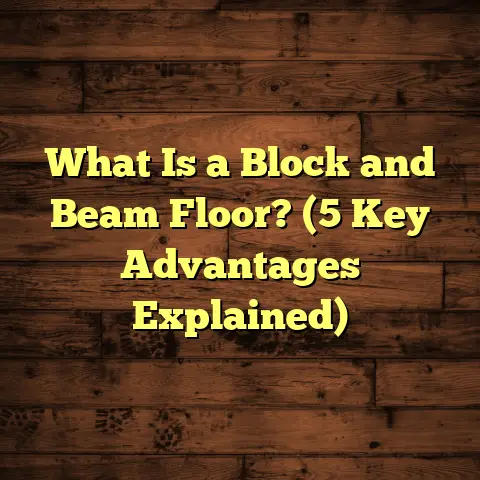What is Better: Tile or Laminate Flooring? (5 Key Factors Revealed)
When I was a kid, I used to love the feel of cool tile beneath my feet during the hot summer months. The kitchen floor in our house was always that slightly chilly ceramic tile, with its smooth surface and playful pattern. In contrast, the living room had laminate floors that mimicked wood—warm, inviting, and perfect for barefoot evenings with family gathered around. Those early impressions stuck with me, shaping how I think about flooring now as a professional contractor. Flooring isn’t just about what looks good; it’s about how it feels day-to-day, how it wears over time, and how it fits your lifestyle.
Picking between tile and laminate flooring is one of the most common dilemmas I help homeowners solve. Both options have strong points but serve different needs. Over the years, I’ve installed these floors in hundreds of homes, each with its own set of challenges and preferences. In this article, I’ll share everything I’ve learned—facts, personal stories, data, and practical advice—to help you decide which flooring is better for your home. We’ll focus on five key factors: durability, installation, water resistance, aesthetics, and maintenance. By the end, you’ll have a clear picture of what works best for you.
What Is the Difference Between Tile and Laminate Flooring?
Before we dive into the details, let’s clarify what we’re talking about.
Tile flooring refers mainly to ceramic or porcelain tiles laid down in rooms. These tiles are made from natural clay or minerals that are baked at high temperatures until hard. Porcelain tiles are denser and fired longer than ceramic tiles, making them even more durable and water-resistant. Tile can come in various shapes, sizes, colors, and finishes—from glossy to matte—and can be arranged in patterns or mosaics.
Laminate flooring is a manufactured product designed to imitate natural surfaces like wood or stone. It consists of several layers: a fiberboard core that provides stability; a photographic layer that shows the design (wood grain, stone texture); and a clear protective layer on top to resist scratches and wear. Laminate is usually installed as floating floors with a “click-lock” system that doesn’t require glue or nails.
Both options are popular for residential use but serve different purposes depending on where you place them and how you use your space.
1. Durability: Which Flooring Stands Up to Life’s Wear and Tear?
When I assess flooring options with clients, durability is often the first question: “How long will this floor last?” or “Will it resist scratches and damage?” Let’s break down what durability means for tile and laminate.
Tile’s Durability
Tile flooring stands out as one of the toughest materials available for floors. Ceramic tiles are strong but can chip or crack if heavy objects fall on them. Porcelain tiles are denser and less prone to cracking or scratching.
From my experience working in homes with children and pets, tile almost always holds up better in high-traffic areas. One client had a dog that loved to run through the kitchen at full speed; their porcelain tile floor remained pristine even after years of use.
Tile also resists staining because its surface is hard and impervious to liquids. Even if something spills, you can clean it quickly without worrying about permanent damage.
Data insight: The Tile Council of North America estimates that porcelain tile can last 50 years or more under normal household conditions with proper maintenance.
Laminate’s Durability
Laminate has made huge strides over the past decade. Earlier versions could scratch easily or swell at the slightest moisture exposure. Today’s laminates come with tough wear layers designed to resist scratches from shoes or furniture movement.
Still, laminate floors are not as hard as tile. Sharp objects dropped on laminate may cause dents or chips. Also, because laminate has a fiberboard core, water damage is a serious risk. If water seeps in through seams or damaged planks, swelling and warping can ruin your floor quickly.
In my projects, laminate tends to last around 10-15 years in rooms with lower moisture exposure like bedrooms or offices but less time in kitchens or bathrooms unless you choose waterproof versions.
Real-World Example
I worked on a home where laminate was installed in a busy mudroom near an entry door. Despite careful cleaning, muddy shoes often left moisture behind, causing swelling in some planks within 2 years. The owners ended up replacing that section with porcelain tile for better longevity.
2. Installation: How Much Time, Skill, and Money Does It Take?
Installation affects your initial cost and how long your project takes—two factors many homeowners worry about.
Tile Installation Details
Tile installation is a craft that demands precision. The subfloor needs to be perfectly flat because uneven surfaces can lead to cracked tiles later on. Mortar or thinset adhesive is spread on the floor, then tiles are laid carefully with spacers to maintain grout lines.
After setting for 24-48 hours, grout fills the gaps between tiles, which must be sealed after drying to prevent stains and moisture penetration.
Because of this multi-step process, tile installation costs more in labor and materials than laminate. On average:
- Material costs: $1-$15+ per square foot depending on tile style.
- Labor costs: $5-$10 per square foot.
- Total: $7-$25 per square foot including installation.
Installation times vary based on room size and complexity but expect several days for a typical kitchen or bathroom.
Laminate Installation Made Easy
One reason laminate became so popular is its easy installation method. Most laminates use a floating floor system where planks snap together without nails or glue.
You can install laminate over existing hard floors (like tile or vinyl) if the surface is flat and clean. Many homeowners choose to DIY their laminate project because of the straightforward click-lock system.
Typical costs:
- Material costs: $1-$5 per square foot.
- Labor costs: $2-$5 per square foot if hiring pros.
- Total: $3-$10 per square foot.
Installation usually takes one day for an average-sized room when done by professionals; DIY projects might take a weekend.
My Story
I once helped a young couple install laminate in their basement themselves. They were nervous at first but found the process fun after watching some tutorial videos online. It saved them over $1,000 compared to professional tile installation quotes they received for alternative flooring options.
3. Water Resistance: Which Floor Can Take Spills and Humidity?
Water resistance is vital for kitchens, bathrooms, mudrooms—anywhere moisture is common.
Why Tile Excels Here
Tile shines in wet areas because it doesn’t absorb water. Porcelain especially has low water absorption rates (typically below 0.5%), making it highly resistant to moisture damage.
Grout lines can be vulnerable but sealing grout properly can prevent mold growth and stains effectively.
Many homeowners I’ve worked with install tile backsplashes in kitchens along with tile floors for seamless waterproofing.
Laminate’s Moisture Challenge
Traditional laminate is sensitive to water exposure because of its fiberboard core. Even small leaks under appliances or spills left unattended can cause planks to swell and buckle.
Recently, manufacturers introduced waterproof laminates with improved core materials such as high-density fiberboard treated for moisture resistance or composite cores made from plastic polymers.
However, these waterproof laminates are pricier and still not as foolproof as tile in wet environments.
Case Study
A family I worked with chose waterproof laminate for their kitchen renovation after reading about its benefits online. After six months of daily cooking and spillages, they noticed some edges lifting near the sink area—something that wouldn’t happen with tile but was tolerable given their budget constraints.
4. Aesthetics: Which Flooring Matches Your Style?
The look and feel of your floor influence your entire home’s vibe.
Tile’s Design Flexibility
Tile comes in countless styles:
- Glossy or matte finishes.
- Large-format tiles that make rooms look bigger.
- Patterns like herringbone or geometric designs.
- Textured surfaces mimicking natural stone or wood grain.
- Color options ranging from classic whites and grays to bold blues or terracottas.
You can even combine tiles with decorative borders or mosaics for artistic flair.
From my projects, I’ve seen tile transform kitchens into bright modern spaces or rustic farmhouse kitchens with warm stone-look tiles.
Laminate’s Wood-Like Warmth
Laminate’s biggest selling point is its ability to mimic hardwood at much lower cost. Advances in printing technology produce realistic wood grain patterns with textures matching oak, maple, cherry, hickory—you name it.
Laminate floors bring warmth and coziness that colder tile sometimes lacks underfoot.
I remember installing laminate in a client’s living room who wanted hardwood look but had pets and kids making hardwood impractical due to scratching concerns.
Combining Both?
Sometimes mixing materials works well—tile in wet zones like entryways or kitchens paired with laminate in living rooms creates both function and style harmony.
5. Maintenance: How Much Effort Will You Spend?
Maintenance impacts how your floors look over time and your satisfaction level.
Tile Maintenance Basics
Tile floors are one of the easiest to keep clean:
- Regular sweeping/vacuuming removes dirt.
- Damp mopping with mild detergent keeps tiles shiny.
- Grout lines need resealing every few years to prevent discoloration.
- Occasional grout cleaning helps avoid mold buildup in humid climates.
I often recommend sealing grout soon after installation as an inexpensive step that prolongs grout life significantly.
Laminate Cleaning Tips
Laminate requires gentle care:
- Sweep or vacuum regularly.
- Use damp mop sparingly; avoid soaking.
- Clean with laminate-specific cleaners for best results.
- Avoid abrasive tools that scratch wear layers.
- Replace damaged planks if needed — repairs aren’t always possible on laminate surfaces.
My Advice
If you want a low-maintenance floor for a busy household with kids who track dirt inside daily, tiled floors usually require less upkeep long-term if grout maintenance is done right.
For those who prefer quick cleaning routines without worrying about sealing grout lines but don’t mind replacing laminate after some years, laminate floors fit well.
Additional Factors That Might Influence Your Choice
Comfort Underfoot
Tile feels cooler and harder beneath your feet compared to laminate’s slightly softer texture due to its fiberboard core.
If you live in cold climates without radiant floor heating, laminate may feel cozier during winter months.
Environmental Impact
Both materials have environmental considerations:
- Tile production involves high-energy firing processes.
- Laminate manufacturing uses adhesives and plastics—some brands offer eco-friendly options with recycled content.
If sustainability matters to you, seek out certified products with low VOC emissions and responsible sourcing labels.
Resale Value
Tile floors often add higher resale value because of their durability and timeless appeal especially in kitchens/bathrooms.
Laminate can boost resale value too but may not have the same long-term cachet as real stone or ceramic tile surfaces.
Personal Stories From My Projects
Over the years, I’ve helped families through these decisions many times:
- A young couple renovating their first home chose durable porcelain tile throughout their kitchen and hallway because they wanted longevity despite higher upfront costs.
- A retiree downsizing preferred warm-looking laminate in her living room for comfort but added tile in the bathroom for practicality.
- A family with two toddlers selected waterproof laminate for their playroom so spills wouldn’t ruin flooring yet enjoyed hardwood-look warmth during cozy family time.
Each choice was different but rooted in matching flooring strengths with lifestyles.
Understanding Cost: A Closer Look With Data
Flooring costs vary widely based on material quality, installation complexity, region, and additional expenses like subfloor prep or removal of old flooring.
Here’s an average cost breakdown per square foot based on projects I’ve managed combined with recent market surveys:
| Item | Laminate Cost Range | Tile Cost Range |
|---|---|---|
| Material | $1 – $5 | $1 – $15+ |
| Installation (pro) | $2 – $5 | $5 – $10 |
| Removal old flooring | $1 – $3 | $1 – $3 |
| Grout sealing | N/A | $0.50 – $1 |
| Waste factor | 5%-10% extra material | 10%-15% extra material |
Example: For a 500 sq ft kitchen renovation:
- Laminate total cost range: $1,500 – $5,000
- Tile total cost range: $3,500 – $12,500
This wide gap highlights how budget influences choice aside from aesthetics or durability preferences.
Tips From My Experience To Help You Choose Wisely
- Evaluate your lifestyle first: If you have kids or pets who bring dirt indoors constantly, durable tile might save headaches later.
- Consider moisture exposure realistically: Kitchens spill often; bathrooms get steamy; basements might be damp—tile typically wins here.
- Think about DIY vs hiring pros: Laminate is easier for beginners; tile requires skill but pays off with long-term durability.
- Balance upfront cost vs lifespan: Sometimes spending more initially saves money over decades by avoiding replacements.
- Don’t forget comfort preferences: Walking barefoot every day? Choose floors that feel good underfoot along with looking good.
- Check local climate effects: Cold climates might favor warmer surfaces like laminate unless radiant heating installed under tiles.
- Use online tools like FloorTally: They help estimate local labor/material costs so your budget matches reality without surprises.
- Ask about warranties: Some tile brands offer lifetime warranties; laminate warranties often cover limited years depending on wear resistance class.
- Plan maintenance routine upfront: Knowing how much effort you’re willing to invest keeps expectations realistic.
- Request samples: Lay them down at home during different times of day under natural light before deciding visually.
Final Thoughts: What Flooring Fits You Best?
Deciding between tile and laminate isn’t about finding one “better” than the other universally—it comes down to matching flooring features with your unique needs:
- Want a tough surface that handles moisture like a champ? Go tile.
- Need affordable warmth resembling wood plus easy installation? Laminate works well.
- Planning long-term investment with minimal replacement? Tile lasts longer.
- Looking for quick makeover within budget? Laminate offers solid value.
- Prefer low-maintenance cleaning? Tile edges out slightly if grout sealed properly.
- Crave cozy underfoot comfort? Laminate feels softer and warmer generally.
I hope this detailed guide helps you feel confident choosing floors that suit your lifestyle and personal taste while fitting your budget wisely!
If you want personalized advice tailored specifically for your home layout or local conditions—or need help interpreting cost estimates from tools like FloorTally—I’m always happy to assist further!
What kind of flooring are you leaning towards now? Have you experienced any challenges with your current floors? Share your thoughts—I’d love to hear what matters most to you when it comes to flooring choices!





